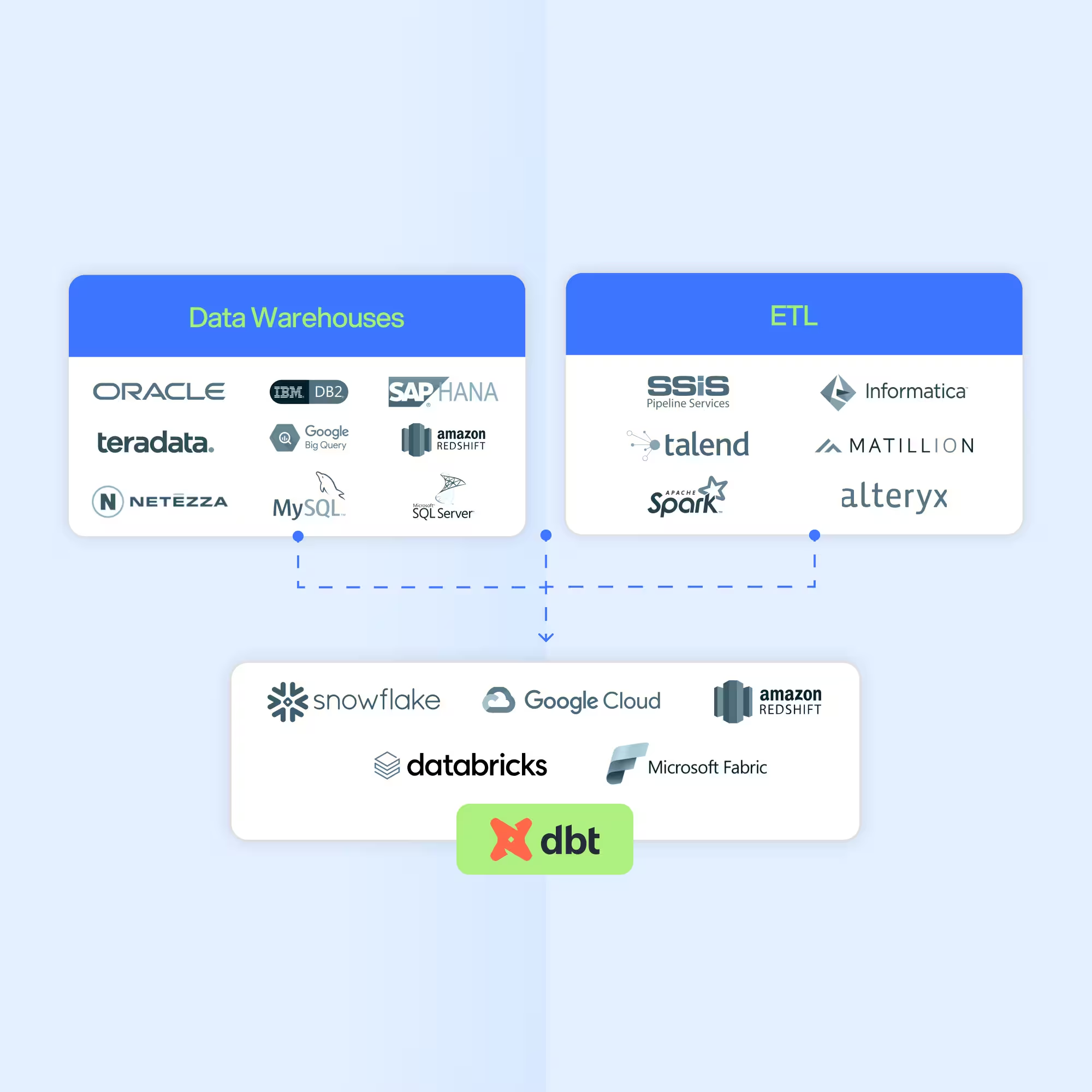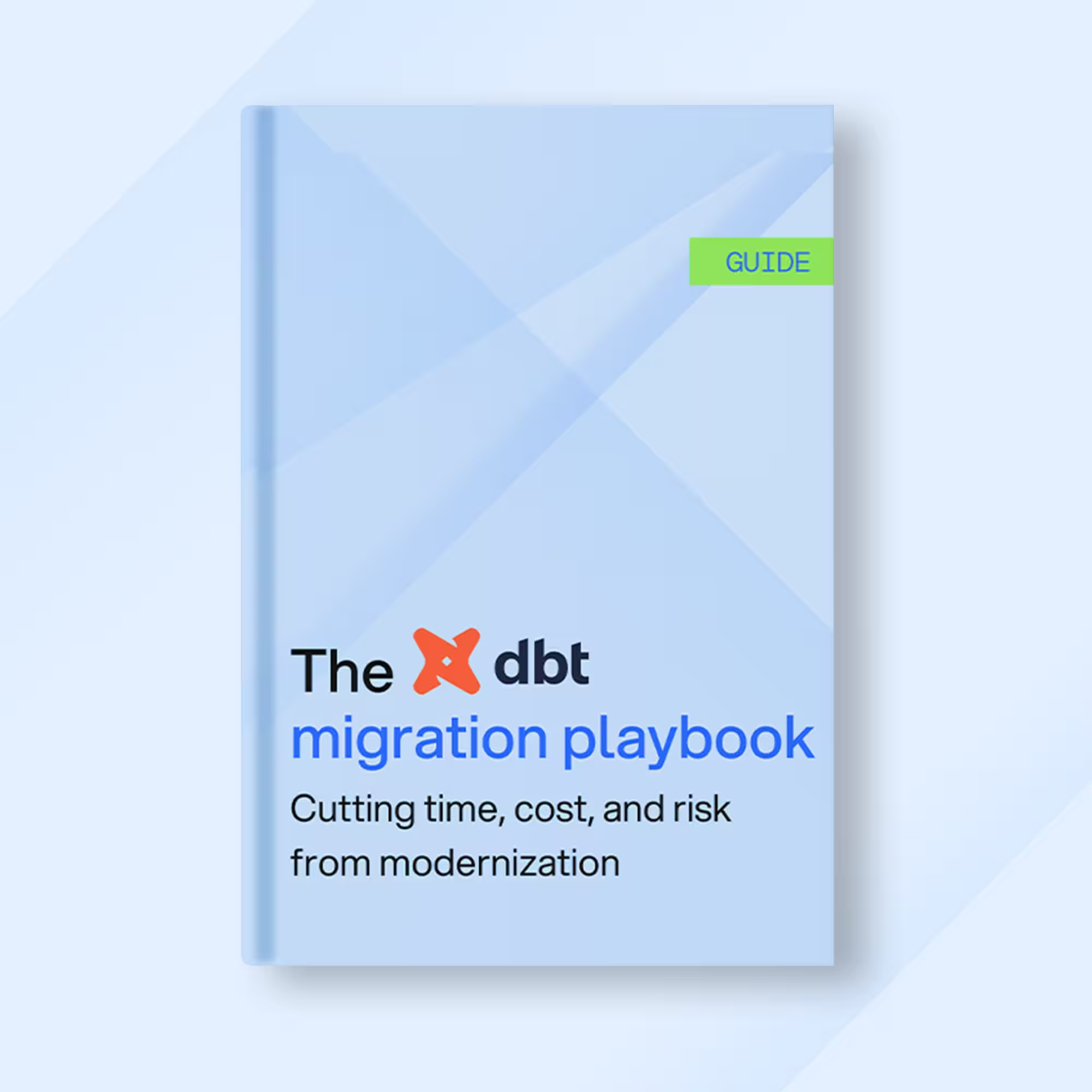The fastest migrations to dbt
Fully translated and validated dbt models delivered on a guaranteed timeline at a fixed price.
How Datafold delivers dbt migrations
Get clean, validated dbt code—no matter your starting point.

From any source to dbt models
We support migrations from any source—SQL dialects, stored procedures, and ETL tools like Informatica, SSIS, and Talend—and output clean, modular dbt code ready for your modern data stack.

AI-powered, human-verified
Our AI automates the heavy lifting–translating SQL, stored procedures, and ETL logic into dbt models—while keeping engineers in the loop for oversight, edge cases, and refinement. It gets smarter with every project, so future migrations move even faster.

Validated and production-ready
Every dbt model we deliver arrives ready for production. Each translation is automatically validated with Data Diff—our cross-database diffing engine that proves 1:1 parity with your legacy outputs. You get clean, modular dbt code that’s optimized, testable, and ready for immediate deployment.

Datafold is the fastest way to modernize with dbt
Migrations used to take months of rewrites, endless validation, and risky cutovers. We’ve built a better way.
Guaranteed timelines
We commit to a delivery date and hit it. Your dbt migration is backed by a proven process that blends AI automation with human oversight to eliminate manual toil. From day one, you’ll know exactly when your models will be ready for production.
Fair, set price
Our outcome-based pricing is tied to the number of models and the complexity of your migration–not time and materials. We scope every migration upfront and commit to delivering within that scope, so there are no hidden costs. You’ll know exactly what you’re getting, when you’re getting it, and what it will cost before work begins.
Battle-tested on complex workloads
From rewriting 300k-character stored procedures to migrating 1,000+ legacy queries, we’ve helped teams across industries modernize faster—with full validation and zero rewrite chaos. Whether you’re moving off Informatica, repointing dbt models, or retiring legacy ETL, we’ve delivered results on time, within scope, and with full stakeholder confidence.
Choose a migration path that fits how you work
Whether you own the migration or deliver it for clients— there’s a faster and better way to get to dbt.
Upgrade to dbt without code freezes or opportunity cost
We run your migration from start to finish, delivering production-ready dbt models without pulling your team off high-value work. There’s no need to enforce a code freeze or pause critical initiatives—we handle the heavy lifting. You get a guaranteed delivery date, a fixed price, and a seamless cutover without having to manage the process.
Your competitive edge in migration delivery
Whether you want to white-label or co-deliver, Datafold plugs directly into your delivery model and accelerates your dbt delivery work. Faster delivery means stronger bids, higher margins, and more capacity to take on projects. You reduce manual effort, improve margins, and expand into dbt modernization projects without adding headcount or overhead.
How we think about getting dbt migrations right, the first time
We wrote this guide to share what actually works in the toughest migrations—like breaking down 300k-character stored procedures into clean dbt models, and validating every output for 1:1 parity.


Make data migrations painless. See how top teams achieve speed and confidence.
Got questions?
We've got answers.
What kinds of dbt migrations does Datafold support?
Datafold can handle both legacy-to-dbt migrations (e.g. Informatica, Talend, Datastage, or stored procedures translated into dbt models) and dbt repointing projects (such as moving between modern cloud warehouses). In both cases, every workload is translated and validated to ensure 1:1 parity and production-ready dbt models.
What type of security does Datafold offer?
Datafold is SOC 2 Type II, GDPR, and HIPAA-compliant and provides flexible deployment options including in-VPC deployment in AWS, GCP, or Azure.
How does Datafold ensure we’re comparing apples to apples?
DMA includes a Source Aligner that locks in consistent snapshots across legacy and new systems. That way, validation reflects actual transformation differences and not drift from unaligned environments.
What if we’re already mid-migration? Can DMA still help?
Absolutely. Whether you’re just starting or already partway through, DMA can plug in to validate your existing translation, catch data mismatches, and accelerate the final stretch with confidence.
How does Datafold help accelerate migrations?
Datafold provides a full-cycle migration automation solution for data teams, which includes code translation and cross-database reconciliation. Specifically, Datafold leverages an AI-powered agent (the Datafold Migration Agent) and cross-database diffing to convert SQL code and validate tables across databases.
What if transformations are defined in a GUI tool and stored as XML or some proprietary format?
Datafold can work with a variety of transformation definitions including those exportable to XML and vendor-specific formats.
How does cross-database diffing work?
First, Datafold connects to any SQL source and target databases, similar to how BI tools do. Second, Datafold does not need to extract the entirety of the datasets for comparisons. Instead, Datafold relies on stochastic checksumming to identify discrepancies and only extract those for analysis.
How can my team run data diffs?
Users can trigger diffs through a variety of ways, including the Datafold UI, REST API, and on schedule using a cross-database diffing monitor.



.avif)
